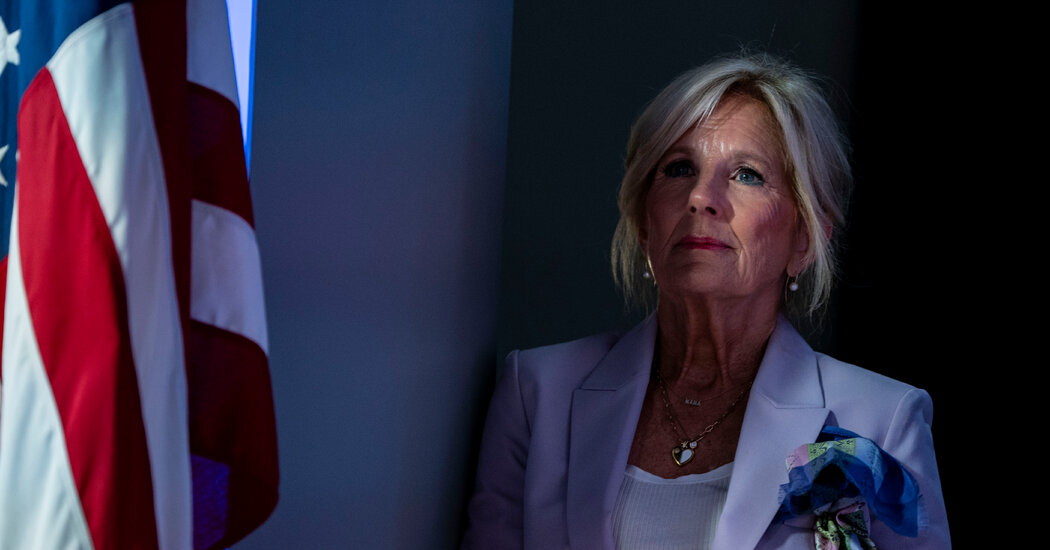AMERICAN WOMAN: The Transformation of the Modern First Lady, From Hillary Clinton to Jill Biden, by Katie Rogers
In an election year that already promises, at best, rancorous division, a rare point of consensus among Americans is this: The first lady seems nice.
Neither beloved like Michelle Obama nor vilified like Hillary Clinton, Jill Biden has managed to dodge most of the bile slung from the right at liberal women. This is good news for her but bad for a biographer, which no doubt explains why Katie Rogers’s “American Woman” interweaves Jill Biden’s story with that of the rise of the modern first lady, from Clinton onward.
Yet the stark differences among these women make it hard to definitively claim what a modern first lady is, what she represents and what a future one — post-Biden and post-Trump — may look like.
Rogers, a White House correspondent for The New York Times, has a light touch and offers a scrupulously evenhanded assessment of her subjects. “American Woman” draws on published memoirs and biographies, as well as interviews with more than 125 people, including Jill Biden, her associates and White House staffers past and present. (You won’t, however, find any scandalous tidbits from aggrieved former staff members.)
With glances back to earlier first ladies, the book digs into how the role has been reshaped since Hillary Clinton’s tenure. Avoiding straightforward chronology, Rogers layers Jill Biden’s story within thematic chapters on her predecessors: “ambition” for Clinton; “tradition” for Laura Bush; “expectation” for Michelle Obama; and, charitably, “reluctance” for Melania Trump. Biden, she suggests, combines all these traits, which add up to a picture so broad it risks losing all nuance.
Part of the problem, Rogers acknowledges, is that the Bidens have been prominent in public life for so long that there is no separating truth from lore. In contrast to Obama and Trump especially, Jill Biden married into politics, and has been on message for almost half a century.
Two aspects of her story disrupt the everywoman political spouse narrative. The first is the circumstances of her marriage, into a family traumatized by the deaths of President Biden’s first wife and 1-year-old daughter. One of the peculiarities of Rogers’s thematic structure is that we don’t hear the full story of the president’s bereavement or his courtship of Jill until nearly two-thirds of the way through the book, after it’s been alluded to numerous times. The tragedy brought out a potent empathy in President Biden and forged in his wife a steely protectiveness: “I remember every slight committed against the people I love,” Rogers quotes, from Jill Biden’s memoir.
The other defining part of Biden’s story was her decision to keep her position as an English professor at Northern Virginia Community College while first lady. Rogers details how the White House had to make accommodations to allow her to continue teaching, and includes several sweet, benign anecdotes from former students. But beyond a handful of outlier right-wing attacks, Rogers doesn’t find much evidence that the country felt too strongly about the first lady keeping her teaching job.
Although Rogers argues that this decision represents a shift in the perception of first ladies, it seems more convincing that teaching — even at a college and with a doctorate in education — is sufficiently feminized, underpaid and belittled that Americans do not see it as detracting from the essentially nurturing role of a first lady.
Rogers herself reveals this bias in an aside — “(She is also not an attorney)” — as she sketches the evolution of acceptable ambition in first ladies, comparing Biden with Clinton and Obama, who both gave up their high-flying legal careers. Biden was perhaps uniquely positioned to direct the role however she chose, after Melania Trump’s norm-busting tenure. (Her predecessor’s notorious “I REALLY DON’T CARE, DO U?” jacket, Rogers suggests, was a turning point that killed any lingering hope that she cared about the responsibilities of the first lady, or that she was some kind of anti-Trump sleeper agent.)
More intriguing for the future of the role are Rogers’s conversations with Douglas Emhoff, the “second gentleman” — “apparently the catchiest title anyone could come up with” — and how he has approached his unprecedented position. Emhoff, too, quit a legal career to support his spouse, Vice President Kamala Harris, yet despite the progressive tilt of a man declaring his pride in supporting a high-powered woman, his day-to-day duties follow a traditional pattern.
It’s a reminder that we still have not found a way to make presidential partnerships a marriage of equals. Perhaps that is impossible while the presidency continues to combine political power with quasi-royal scrutiny and celebrity. Whatever happens in November, those who would like to see a real shift in what a first lady means and what she can do will likely have to wait awhile longer.
AMERICAN WOMAN: The Transformation of the Modern First Lady, From Hillary Clinton to Jill Biden | By Katie Rogers | Crown | 304 pp. | $30


